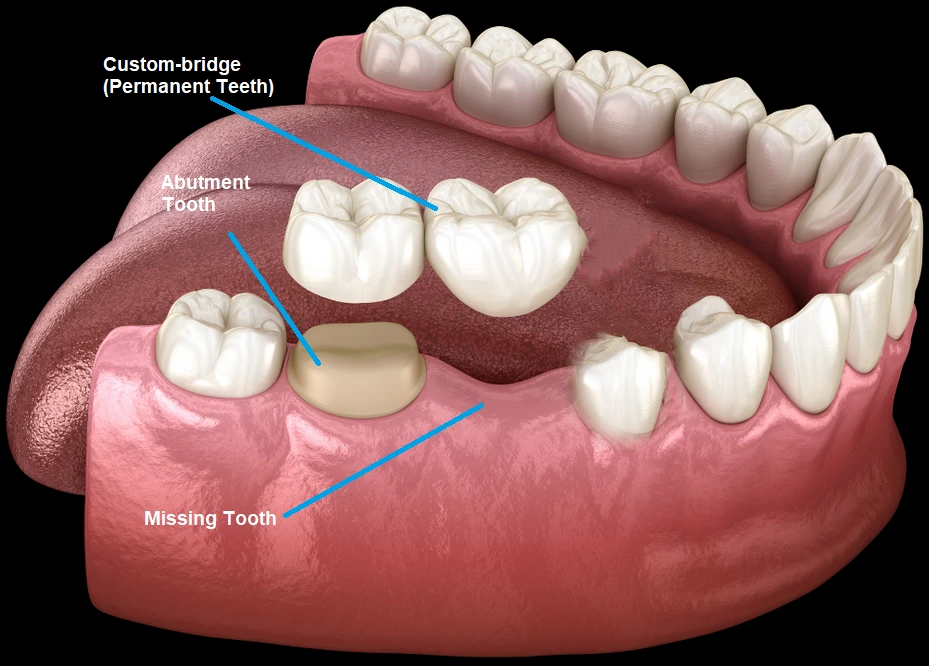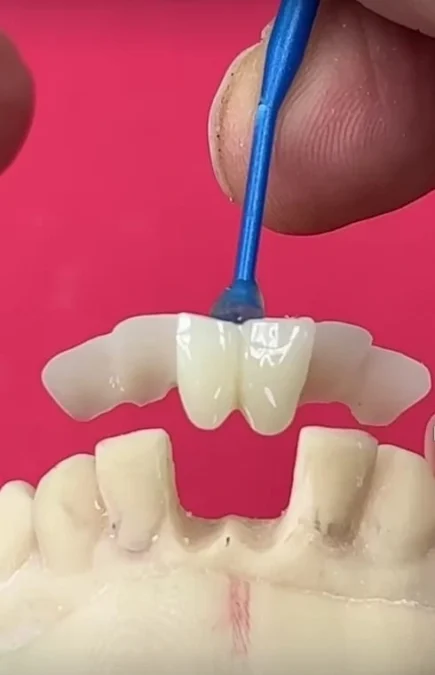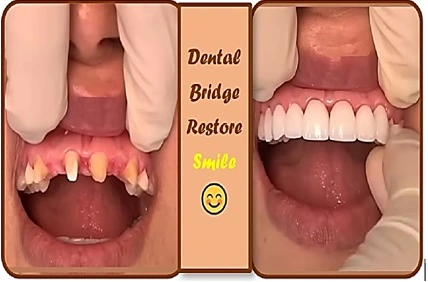What is Dental Bridge
Dental bridges fill the gap left by missing teeth, restoring your ability to chew, enhancing your smile’s appearance, and supporting overall oral health. They’re made up of crowns placed over the natural teeth on either side of the empty space, with one or more artificial teeth—called pontics—bridging the gap.
Dental bridges are a common solution to replace missing teeth and restore oral function and appearance. Alongside, a dental bridge front teeth solution is a popular restorative option for individuals looking to replace missing teeth and restore a confident smile. Many patients are amazed by the dramatic transformation seen in dental bridge before and after comparisons, highlighting the procedure’s ability to restore both function and aesthetics. Sometimes bridges need to reshape the neighboring teeth to support the structure, while dental implants provide an alternative that preserves adjacent tooth enamel by anchoring directly into the jawbone. There are four major types of dental bridges that are discussed here:
1. Traditional Bridge Dental
The earliest and most commonly used type of dental bridge is the traditional bridge. In this kind of teeth replacement, one or more artificial teeth (pontics) are anchored in place by dental crowns that are cemented onto the natural teeth on either side of the gap. This is best for those who have strong adjacent teeth.

The following are five steps that explain the complete dental bridge procedure of replacing missing teeth through traditional bridges:
i. Initial Consultation and Examination
The dentist examines the tooth alignment, gums, and jawbone by taking X-rays or scans
ii. Tooth Preparation
- The two teeth next to the missing tooth are reshaped by removing some enamel (the hard, outer layer of teeth) to make room.
- The dentist makes impressions (molds) of the teeth and sends them to a dental lab to create a custom bridge.
- The dentist creates a temporary bridge to protect the exposed teeth.
iii. Fabrication
Custom bridge (permanent tooth) usually made from porcelain, ceramic or metal alloys, taking 1–3 weeks
iv. Placement and Fitting
- Once the custom bridge is ready, the temporary bridge is removed.
- The dentist cements custom bridges onto abutment teeth.
- Finally, the dentist adjusts and checks the fit, bite alignment, and appearance.
v. Follow-Up & Care
- The dentist advises good oral hygiene, like brushing, flossing under the bridge, and regular dental checkups to prolong the bridge’s lifespan, typically 5 to 15 years.
2. Cantilever Bridge Dental
Cantilever bridges are good for those who have only one adjacent tooth available to support the restoration. It is anchored to a single neighboring tooth, unlike traditional bridges, which require support from teeth on both sides of the gap. This option is good for those missing front teeth where less chewing pressure is involved.

The following five steps explain the complete dental bridge procedure to replace the missing teeth through cantilever bridges:
i. Initial Consultation and Examination
- The process of cantilever bridges is the same as traditional bridges.
- The dentist prescribed scans or X-rays and evaluated the tooth alignment, gums, and jawbone.
ii. Tooth Preparation
- The dentist removes the enamel from the single adjacent tooth (abutment tooth) to reshape it for proper placement of the bridge.
- The dentist then makes impressions (molds) of the tooth and sends them to a dental lab for the creation of a custom-fitted bridge.
- Since the dentist removes enamel from the healthy tooth, they create a temporary bridge to protect it.
iii. Fabrication of the Cantilever Bridge
- The bridge is custom-made, usually from porcelain-fused-to-metal (PFM), ceramic, or zirconia. That takes 1 to 3 weeks.
iv. Placement, Fitting, and Cementation
- The dentist removes the temporary bridge when the custom bridge is ready.
- The custom bridge is permanently cemented to the abutment tooth using dental adhesive or resin cement.
- After cementation, the dentist adjusts and checks the fit, bite alignment, and aesthetics of the custom-fitted bridge.
v. Post-Procedure Care and Follow-Up
- The dentist prescribes oral care instructions and oral hygiene, like proper brushing and flossing around the bridge.
- Proper care can increase the lifespan from 5 to 15 years.
- It is necessary for patients to schedule follow-up appointments regularly to ensure fitness and function.
- A follow-up appointment may be scheduled to ensure proper fitness and function.
3. Maryland Bridge Dental
Maryland bridges, also called resin-bonded bridges, are the 3rd type of dental bridge used to replace missing teeth. This is used typically for the front missing teeth of the mouth for those looking for minimally invasive and cost-effective solutions. However, it may not be recommended for molars (posterior teeth), as their primary function is to grind and crush food.

Here are a few steps involved in the dental bridge process of getting a Maryland bridge:
i. Initial Consultation and Examination
The dentist evaluates the missing teeth area and suggests X-rays or digital scans to precisely check the supporting teeth and bone structure.
ii. Tooth Preparation
The dentist prepares the backside of the adjacent teeth (abutment teeth) by removing a small amount of enamel to create space for the metal or ceramic wings of the bridge
iii. Impression and Temporary Bridge
- The dentist takes a dental impression to create an accurate model of the teeth.
- The model is then sent to a dental lab to fabricate the bridge.
- A temporary bridge, in some cases, is created to create the prepared teeth while, in the meantime, the final bridge is being made.
iv. Bridge Fabrication
- The Maryland bridge is usually made from porcelain-fused-to-metal (PFM), all-ceramic, or composite resin.
- The shape of the bridge contains pontic (artificial teeth) and metal or ceramic wings that attach to the back of the adjacent teeth.
v. Bridge Fitting and Polishing
- The dentist fits the bridge by checking the fit, color, and bite.
- The dentist also etches the wings tightly with acid to increase bonding.
- Resin cement is used to bond the bridge to the back of the abutment teeth.
- At the final stage, the dentist removes the extra cement and polishes the bridge for a natural look.
- The dentist advises the patient to avoid sticky or hard food initially, maintain good oral hygiene, and schedule regular checkups.
4. Implant-Supported Bridge
An implant-supported bridge uses dental implants as abutments instead of natural teeth to replace missing teeth. It is the 4th and last type of dental bridge. If there is one or more than one missing tooth (molar or premolar), then this option is good to fill the space efficiently.
Getting an implant-supported bridge involves the following main steps, typically carried out over several months:
i. Initial Consultation & Examination
- The dentist performs X-rays and 3D scans (CBCT) to evaluate bone density and gum health.
- This also helps the dentist to decide whether the candidate is good for an implant-supported bridge or not.
ii. Tooth Extraction and Bone Grafting
- If there are any decayed or damaged teeth in the area, the dentist removes them, which can take some time to heal before implant placement.
- For strengthening the jawbone, bone graft material is added that typically takes 3 to 6 months to heal, depending on the extent of grafting.
iii. Implant and Abutment Placement Surgery
- Titanium implants are placed surgically into the jawbone. This process is called osseointegration (bone fuses with implant) and takes 3 to 6 months for healing.
- A small connector that is called an abutment is attached to the implant, and then gums are allowed to heal around it, taking 1 to 2 weeks.
iv. Impressions & Bridge Fabrication
- The dentist takes the impression and sends it to the dental lab to design a custom bridge, typically taking a few weeks.
- Once the custom bridge becomes ready, the dentist attaches it to the implants.
- The dentist checks for comfort, bites, and function.
- The dentist also advises oral hygiene and follow-up visits.
A: A dental bridge is not considered permanent but proper care and oral hygiene can typically last from 5 to 15 years or more before needing replacement
A: If the dental bridge is old, damaged, or no longer fits properly, it is important to visit the dentist for evaluation. An old bridge dental may need repairs or full replacement.
A: The best dental floss for bridges is a floss threader or super floss, specially designed to clean under and around dental bridges where regular floss can’t reach.
A: Before and after dental bridge results often show a significant improvement in smile appearance, chewing ability, and overall dental function, making it a popular choice for replacing missing teeth.
A: Dental bridge cost varies depending on the type, material, and location, but on average, it ranges from $500 to $1,500 per tooth. Additional costs may apply for exams, X-rays, or related treatments.

